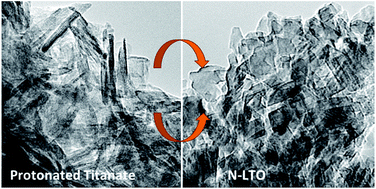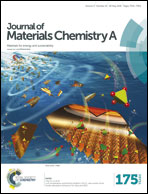N-doped Li4Ti5O12 nanoflakes derived from 2D protonated titanate for high performing anodes in lithium ion batteries†
Abstract
Safety, the current rate capability and cycle life are important features of high performance lithium ion batteries (LIBs). Herein dehydrated, mesoporous nitrogen doped Li4Ti5O12 (N-LTO) containing highly crystalline, 2D nano-sized flakes were prepared via a facile hydrothermal process followed by calcination in air. A layered protonated titanate with a small quantity of nitrogen compounds was precipitated by the hydrothermal method, and used as the precursor for Li4Ti5O12 (LTO). The presence of nitrogen within the intermediate led to nitrogen doped LTO after calcination. The optimal calcination temperature was obtained by monitoring the thermal transformation from the protonated titanate precursor to spinel LTO using in situ and ex situ analyses. The optimised N-LTO nanoflakes showed excellent high current rate capability and cycle life when applied as an anode for LIBs: having a capacity of 95.4 ± 16.5 mA h g−1 when cycled at a very high current (120C), and exhibiting a low capacity loss (∼9%) after 2288 cycles at 5C. These properties are attributed to the combined characteristics of these N-LTO nanoflakes, including abundant mesopores, high surface area (86 m2 g−1), 2D nanoflake building blocks, nitrogen doping, as well as being water-free and highly crystalline.


 Please wait while we load your content...
Please wait while we load your content...